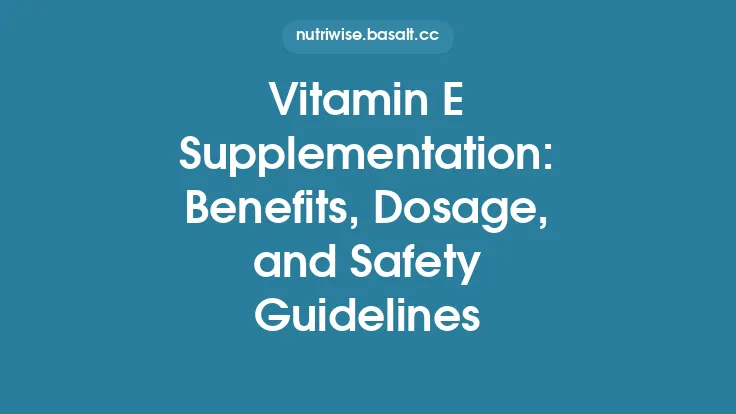Vitamin K is best known for its essential role in the clotting cascade, but the decision to supplement this micronutrient is far from straightforward. While many people assume that “more is better,” the reality is that vitamin K supplementation can be a powerful therapeutic tool when used judiciously, yet it can also pose significant risks if taken without proper guidance. This article walks through the evidence‑based reasons to consider a supplement, the clinical contexts in which it shines, and the red flags that signal a need for caution. By the end, you should have a clear framework for deciding whether a vitamin K supplement is appropriate for you or a patient under your care, and how to manage it safely.
Why Consider Vitamin K Supplementation?
1. Addressing Subclinical Insufficiency
Even in the absence of overt deficiency symptoms, certain individuals may have chronically low plasma vitamin K concentrations due to poor dietary intake, malabsorption syndromes (e.g., celiac disease, chronic pancreatitis), or long‑term use of broad‑spectrum antibiotics that disrupt gut flora. Subclinical insufficiency can subtly impair the γ‑carboxylation of clotting factors II, VII, IX, and X, leading to a modest prolongation of prothrombin time (PT) that may become clinically relevant during surgery or trauma.
2. Supporting Peri‑operative Hemostasis
Elective surgeries—particularly orthopedic procedures, cardiac bypass, and major abdominal operations—require optimal coagulation status. Randomized trials have shown that a short course (3–5 days) of oral vitamin K₁ (phylloquinone) at 5–10 mg can normalize PT and reduce intra‑operative bleeding in patients identified as having low baseline vitamin K status.
3. Counteracting Drug‑Induced Depletion
Certain medications, such as long‑acting antibiotics (e.g., rifampin) and lipid‑lowering agents (e.g., bile‑acid sequestrants), can diminish vitamin K absorption or hepatic recycling. In these scenarios, supplementation can restore adequate levels and prevent secondary coagulopathy.
4. Managing Specific Genetic Variants
Polymorphisms in the VKORC1 gene (vitamin K epoxide reductase complex subunit 1) can affect the efficiency of vitamin K recycling. Individuals homozygous for the “low‑activity” allele may have a higher baseline requirement for vitamin K to maintain normal clotting factor activation. Targeted supplementation, guided by genetic testing, can normalize coagulation parameters.
Clinical Scenarios Where Supplementation Is Beneficial
| Clinical Situation | Recommended Form | Typical Dose | Duration |
|---|---|---|---|
| Malabsorption (e.g., Crohn’s disease, bariatric surgery) | Vitamin K₁ (phylloquinone) oral tablets | 5–10 mg daily | 4–6 weeks, then reassess |
| Pre‑operative optimization (low PT/INR) | Vitamin K₁ oral or sub‑cutaneous | 5 mg oral or 2.5 mg SC | 1–3 days before surgery |
| Long‑term antibiotic therapy (>2 weeks) | Vitamin K₂ (menaquinone‑7) softgels | 100–200 µg daily | Throughout antibiotic course |
| Genetic VKORC1 low‑activity variant | Vitamin K₂ (MK‑7) | 200–300 µg daily | Ongoing, with periodic PT monitoring |
| Chronic liver disease with borderline PT | Vitamin K₁ oral | 2.5–5 mg daily | 2–4 weeks, then evaluate response |
*Note: Doses above are typical ranges derived from clinical trials and guideline consensus; individual needs may vary.*
Potential Risks and When to Exercise Caution
1. Over‑correction in Anticoagulated Patients
Patients on vitamin K antagonists (e.g., warfarin) are especially sensitive to changes in vitamin K intake. Even modest supplementation can blunt the drug’s effect, leading to sub‑therapeutic INR values and a heightened risk of thrombosis. In such cases, any supplement should be introduced only under close medical supervision, with frequent INR checks.
2. Hypercoagulability Concerns
Excessive vitamin K can theoretically tip the hemostatic balance toward hypercoagulability, particularly in individuals with underlying pro‑thrombotic disorders (e.g., factor V Leiden, antiphospholipid syndrome). While large‑scale data are limited, case reports suggest that very high doses (>20 mg/day) may precipitate venous thromboembolism in predisposed patients.
3. Interaction with Certain Chemotherapeutics
Some chemotherapeutic agents (e.g., anthracyclines) rely on oxidative stress mechanisms for cytotoxicity. Vitamin K, being a potent antioxidant, could theoretically attenuate drug efficacy. Oncology patients should discuss supplementation with their treatment team before initiating any vitamin K product.
4. Neonatal Considerations
Newborns receive a prophylactic intramuscular dose of vitamin K₁ at birth to prevent hemorrhagic disease. Additional oral supplementation beyond the standard protocol is not recommended unless a specific deficiency is identified, as it may interfere with the intended pharmacokinetics of the prophylactic dose.
5. Allergic or Sensitivity Reactions
Although rare, some individuals may react to excipients in commercial vitamin K preparations (e.g., soy oil, gelatin). A thorough review of the supplement label is essential for patients with known food allergies.
Choosing the Right Form and Dosage
Vitamin K₁ (Phylloquinone) vs. Vitamin K₂ (Menaquinone)
| Attribute | Vitamin K₁ | Vitamin K₂ (MK‑4) | Vitamin K₂ (MK‑7) |
|---|---|---|---|
| Source | Plant chlorophyll (leafy greens) | Animal tissues, fermented foods | Bacterial fermentation (natto) |
| Half‑life | ~1–2 hours | ~1 hour | ~72 hours |
| Primary Use | Rapid correction of PT/INR | Short‑term hepatic carboxylation | Sustained extra‑hepatic carboxylation (e.g., bone, vasculature) |
| Typical Clinical Dose | 1–10 mg (acute) | 0.5–5 mg (short‑term) | 100–300 µg (maintenance) |
- Acute correction (e.g., pre‑operative) favors vitamin K₁ because of its rapid hepatic uptake.
- Long‑term maintenance in malabsorption or genetic contexts often utilizes MK‑7 due to its prolonged plasma presence, allowing for lower daily doses.
Formulation Considerations
- Oral tablets/capsules are the most convenient and have predictable absorption when taken with a modest amount of dietary fat.
- Sub‑cutaneous injection (vitamin K₁) is reserved for patients unable to tolerate oral intake or when a rapid rise in clotting factors is required.
- Liquid emulsions may be advantageous for patients with severe malabsorption, as they bypass some of the dissolution steps required for solid dosage forms.
Monitoring and Follow‑Up
- Baseline Assessment
- Obtain PT/INR (or aPTT if indicated) before initiating supplementation, especially in patients with known coagulation disorders or on anticoagulants.
- Measure serum vitamin K levels if available (high‑performance liquid chromatography) to confirm deficiency.
- During Therapy
- Re‑check PT/INR 24–48 hours after the first dose of vitamin K₁, then weekly until stable.
- For MK‑7 regimens, monitor PT/INR every 2–4 weeks, as the longer half‑life yields a more gradual effect.
- Post‑Therapy Evaluation
- After discontinuation, repeat coagulation studies to ensure values remain within target ranges.
- Document any adverse events (e.g., unexpected thrombosis, bleeding) and adjust future dosing accordingly.
Special Populations: Children, Pregnant Individuals, and the Elderly
Children
Infants and young children have higher relative vitamin K turnover due to rapid growth. While routine supplementation is not recommended for healthy children, those with chronic cholestasis, cystic fibrosis, or prolonged antibiotic exposure may benefit from low‑dose oral vitamin K₁ (0.5–1 mg daily) under pediatric supervision.
Pregnant and Lactating Individuals
Physiological changes in pregnancy increase the demand for vitamin K, yet the placenta limits its transfer to the fetus. Supplementation is generally unnecessary unless the mother has a documented deficiency or is on medications that impair vitamin K metabolism. Doses should not exceed 1 mg/day to avoid potential interference with anticoagulant therapy that may be prescribed for pregnancy‑related thrombophilia.
Elderly
Age‑related decline in intestinal microbiota and hepatic function can reduce endogenous vitamin K synthesis. A modest daily MK‑7 supplement (100–200 µg) can help maintain adequate clotting factor carboxylation without significantly affecting anticoagulant therapy, provided INR is monitored regularly.
Practical Tips for Safe Supplement Use
- Start Low, Go Slow – Begin with the lowest effective dose and titrate based on laboratory response.
- Take with Fat – Vitamin K is fat‑soluble; a small amount of dietary fat (e.g., a teaspoon of olive oil) enhances absorption.
- Avoid Unnecessary Poly‑supplementation – Combining high‑dose vitamin K with other fat‑soluble vitamins (A, D, E) can increase the risk of hypervitaminosis; keep total intake within recommended limits.
- Keep a Medication Log – Document all supplements, prescription drugs, and over‑the‑counter products to help clinicians spot potential interactions.
- Consult Before Surgery – Inform surgeons and anesthesiologists of any vitamin K supplementation at least 48 hours before elective procedures.
- Use Reputable Brands – Choose products that have undergone third‑party testing for purity and potency (e.g., USP, NSF certified).
Bottom Line
Vitamin K supplementation is a nuanced intervention that can correct subclinical insufficiency, improve peri‑operative hemostasis, and counteract drug‑induced depletion. However, its powerful influence on the clotting cascade means that indiscriminate use—especially in individuals on anticoagulants, with pro‑thrombotic conditions, or undergoing major surgery—can be hazardous. By assessing baseline status, selecting the appropriate form and dose, and instituting vigilant monitoring, clinicians and health‑conscious individuals can harness the benefits of vitamin K while minimizing the risks. When in doubt, a collaborative approach involving a primary care provider, hematologist, or pharmacist ensures that supplementation decisions are both evidence‑based and personalized.





